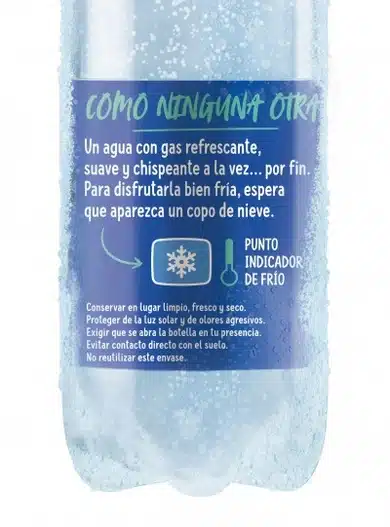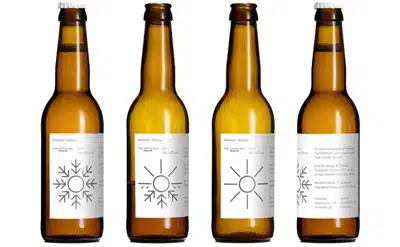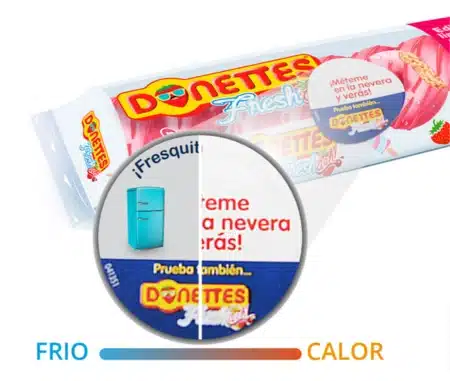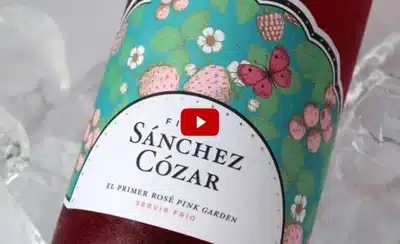
04 Oct Packaging with thermochromatic inks
Index of contents:
- Printing of packaging with thermochromatic inks
- Types of thermochromatic inks
- Technical specifications of thermochromatic inks
- Food and drink labels with thermochromatic inks
Printing of packaging with thermochromatic inks
You have most likely heard of thermochromatic inks, those that change color in response to temperature changes. For some years now, these inks have been a trend in the printing of labels and sleeves to attract the attention of consumers thanks to their originality and surprise effect.
If you are considering applying thermochromatic inks to your packaging, read on. At Rieusset we are specialists in printing labels and sleeves with thermochromatic inks.
Types of thermochromatic inks
Before moving on to the creative part, it is important to know about the nature of this type of inks.
Thermochromic inks contain thermochromes, chemical compounds that are sensitive to temperature and change their molecular structure when cooled or heated. As a result, thermochromes change color depending on the temperature.
They have good printability on paper and polyolefin films. A wide variety of colors are available depending on the client’s wishes: orange, red, magenta, blue, green, black, etc.
There are two types of thermochromatic inks: reversible and irreversible.
Reversible thermochromics
These types of inks change color with temperature variations, but as the name suggests, after the temperature returns to its normal range, the inks become transparent again (actually in normal temperature ranges, the inks are transparent, and when the set temperature threshold is exceeded, they change to a perceptible color). In other words, the color of the ink is reversible and can oscillate between two colors depending on whether it is cooled or heated.
Rieusset currently works with reversible inks suitable for refrigerated beverages, where these inks change color at a certain temperature indicating that the beverage is ready to be consumed.
Non-reversible or irreversible thermochromics
These inks also change color depending on the temperature, but unlike the previously described ones, once they have undergone this change they do not return to their original color. In other words, the color change is permanent.
Irreversible thermochromatic inks are very useful to indicate that a certain temperature has been reached, as in the validation of sterilization temperatures in medical devices or safety products.
In summary, reversible thermochromatic inks change color and then return to their original state when the temperature changes, while irreversible thermochromatic inks change color and do not return to their original state even if the temperature changes again.
Technical specifications of thermochromatic inks
Thermochromatic inks offer endless creative possibilities, but it is essential to work with a company specialized in this type of inks, as there are several important aspects to be taken into account:
- These inks cannot be used in primary packaging, where the packaged products are in prolonged contact with the unprinted side of the packaging, although this is possible provided there is a functional barrier, wherefore it must be ensured that the packaging meets the regulatory requirements for its intended use.
- The compatibility of the ink with the material must be determined prior to production.
- The drying temperature of these inks, as well as the air flow, must be set at high values in comparison with conventional inks in order to for them to dry correctly.
- In rotogravure, the cylinders must be engraved in a special way. Depending on the desired intensity, it is advisable to engrave with a greater or lesser depth. This type of ink is transparent, so it must be maximized in order to achieve the desired application.
- In the case of having to register these inks together with conventional inks, the fact that they are transparent limits the accuracy of the register at high speeds, so the machine must be adapted to this limitation.
- This type of ink is easily contaminated, so extreme precautions should be taken, keeping all parts of the printing machine that come into contact with the ink in perfect condition. Since it is transparent, any minor contamination with a conventional ink makes it unusable, so in addition to the parts of the machine, any tube or tank through which the ink is transported must be completely clean.
- Since these inks contain encapsulated particles, the doctor blades must have a specific position to avoid the breakage of these microcapsules.
- The viscosity must be tested prior to production to achieve the desired effect.
- These inks must be stored in a cool, dry place, away from chemicals and direct light, especially sunlight.
- The expiration date of these products is limited, wherefore we can only stock them upon request to avoid expiration dates and loss of their properties.
In summary, due to the complexity of this type of ink, all applications using thermochromatic inks undergo an in-depth study, both in terms of productivity and food safety, before final approval for production.
Food and drink labels with thermochromatic inks
Here are some examples of food and beverage packaging that use this type of inks:
Font Vella Gas
Rieusset has been the company entrusted with printing the labels for Font Vella Gas sparkling mineral water. The labels have a cold indicator point that shows consumers when the drink is at the right serving temperature. Thus, when the bottle is cold, a snowflake appears on the label.

Via Infopack
Danish Mikkeller beer
The Pernicals Bedow studio has designed the label for a special edition of Mikkeller beer that uses thermochromatic inks. The label shows either a snowflake or a sun, depending on whether the beer is cold or warm.
This is an example of a very original minimalist design in the Nordic style, which uses this type of inks in a very creative way.

Via Gráffica
Finca Sánchez Cózar wines
Serving wine at the right temperature is quite a challenge, wherefore Eva Arias Graphic Studio has developed special labels with thermochromic inks for the Finca Sánchez Cózar wines of Bodegas Orán.
These are labels that beyond considering the aesthetic and creative aspect, have the objective of helping to show the optimal serving temperature. These are undoubtedly quite innovative and impressive labels, which offer highly valuable information for wine lovers.
Donettes Fresh
Thermochromatic inks are not only for beverages – they are also ideal for food. A good example of this are the delicious Donettes Fresh.
In this case, it’s not just the color that changes, but also the message on the label. The flexible packaging of this product has a sticker that encourages consumers to refrigerate the product for a new and equally tasty experience. This is an effective and original strategy to promote a new way of consuming the product.

Vía Adco
At Rieusset we are leaders in the incorporation of industry trends; we work every day on innovation and technology to offer our clients the latest trends and the best quality. Do you want to innovate in your packaging by applying thermochromatic inks? Contact us, we will advise you.
| We Manufacture: | Meet Rieusset: |



